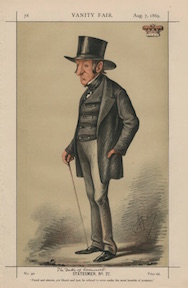Hide
hide
Hide
Transcript
of
Edward Adolphus Seymour, K.G., P.C. [Obituary]
Trans. Devon. Assoc., 1886, Vol XVIII, pp.66-67.
by
Rev. W. Harpley
Prepared by Michael Steer
Edward Adolphus Seymour (later St. Maur), 12th Duke of Somerset, etc., KG, PC (20 December 1804 – 28 November 1885), styled Lord Seymour until 1855, was a Whig aristocrat and politician, who served in various cabinet positions in the mid-19th century, including that of First Lord of the Admiralty. A “custos rotulorum” was the principal justice of the peace in an English county who is also keeper of the rolls and records of the sessions of the peace. The article, from a copy of a rare and much sought-after journal can be downloaded from the Internet Archive. Google has sponsored the digitisation of books from several libraries. These books, on which copyright has expired, are available for free educational and research use, both as individual books and as full collections to aid researchers.

Edward Adolphus Seymour, K.G., P.O., Duke of Somerset, Earl St Maur of Berry Pomeroy, and Baron Seymour of Hache, Lord-Lieutenant and Custos Rotulorum of Devonshire, was born on 20th December, 1804, and was the twelfth duke of his line. He was educated at Christ Church, Oxford. He married, on June 10th, 1839, Jane Georgiana, youngest daughter of the late Thomas Sheridan, Esq., granddaughter of the Right Hon. Eichard Brinley Sheridan, and had two sons and three daughters. Both the sons pre-deceased their father, and the daughters are Lady Hermione Graham, Lady Ulrica Thynne, and Lady Gwendolen Ramsden. Formerly he took a prominent part in public life. As Lord Seymour he sat in the House of Commons as the Liberal member for Totnes, which place he represented from 1834 until called to the Upper House by the death of his father in 1855. He became a Lord of the Treasury in 1835, an office he held until 1839. From 1839 to 1841 he was Secretary to the Board of Control, Chief Commissioner of Woods and Forests from 1849 till 1851, and of Public Works from 1851 to 1852. On the return of Lord Palmerston to power in 1859, his Grace was appointed First Lord of the Admiralty, which he resigned on the fall of the Russell Ministry in 1866. His Grace was at one time a Commissioner of Lunacy, and was made Lord-Lieutenant of Devonshire in 1861, on the death of the late Earl Fortescue. He was also a Governor of the Royal Naval College, and a Trustee of the British Museum. In 1871 the Duke created some sensation by publishing a work entitled Christian Theology and Modem Scepticism, in which he attempted to show that the Acts of the Apostles and the Pauline Epistles frequently contradict one another.
His last public act was to open a cottage hospital at Totnes, October 26th, 1885.
He joined the Association in 1874, and was a Life Member. He died at his country seat. Stover House, on Saturday, November 28th, 1885, within three weeks of his eighty-first birthday. He was succeeded in the title by his brother, Lord Archibald St Maur.
